Use enough scope…but not too much!
By
Craig Boddington
When I was young, the fixed 4X scope was the standard riflescope for hunting big game. Fixed-power scopes of higher magnification existed, but they were primarily used for varmints and
target shooting. Most of us figured a fixed 4X would handle just about any hunting chores. Variable-power scopes existed back then but were widely distrusted because zero shifts were common as magnification changed. The variable-power scope wasn’t completely perfected until the 1970s, so I did my early hunting with fixed 4X. My first variables were 3-9X. Older shooters
grumbled that “a fixed 4X was all the scope any hunter needed.” I did not agree. Wow, the image size at 9X was wonderful.

For years, about three-times-zoom (as in 3-9X) was the technological limit. The thing is, no matter what you’re hunting, not all shots are far. So, with any variable scope, it’s important to have a low-end magnification setting low enough to keep you out of trouble for close shots. Up close, too much magnification, and all you’re likely to see is a wall of hair. Today we have four, five, six, and even eight times zoom capability. This changes the game. A 1-8X scope would seem the ideal setup for a versatile big-bore like a .375. Variables of 2.5-20X or 4-32X would seem to satisfy just about any shooting situation: Extreme magnification for distance; a low-end that’s low enough to allow following up a wounded animal.

Maybe, but there are other practical considerations. You will always pay more for higher magnification and for scopes with the highest zoom ratio. And the scopes will be larger, bulkier, and heavier. The style today is toward bigger scopes. Fine if you need the capability, but I don’t like to add unnecessary weight. Also, bigger scopes must be mounted higher. Adjustable combs and strap-on cheekpieces fix this problem. However, some (most) of my hunting rifles handle just fine with a smaller scope mounted low. So, instead of charging into the big-scope culture, how about evaluating how much magnification you really need?
If you’re part of the growing long-range group, you need high magnification. Doesn’t matter if you’re ringing steel, shooting prairie dogs, or reaching out on big game. My varmint rifles wear big glass. Love to ring steel, too. On game, I’m not an extreme-range shooter. However, with the equipment we have today I’m comfortable shooting farther than when I was young.

Trust me, I embrace magnification. Over the years, I’ve stepped up…but only to a point. When Leupold came out with a 4.5-14X, I got one immediately, used it for a lot of open-country hunting. Today I’ve stepped up a bit farther. On my current open-country rifles, I’ve used several 4-16X and 3-18X scopes. I’ve tried more powerful scopes, but for my hunting, I just don’t need more magnification. Rarely use all that I have, because with high magnification at my fingertips,it’s important to keep the scope turned down. The higher the magnification, the smaller the field of view, thus the slower and more difficult to acquire a distant target.

QUALITY VERSUS QUANTITY
When deciding on a scope for a certain rifle, I like to consider the capability of that rifle…and what I’m likely to use it for. A prairie dog rifle needs a lot of scope. So do the rifles I might take sheep hunting. A rifle for mule deer needs a bigger scope than a rifle for hunting my Kansas whitetails, where few shots exceed 150 yards. My lever-action .308 wears a trim 2.5-8X scope.
My .375s usually wear a 2-7X or 3-9X, this is because the cartridge is more versatile than the low- range variables (such as 1.75-5X) we typically put on a .375. Great for bears and buffaloes, not enough scope for plains game. And, yes, I have a good 1-8X that I’ve moved back and forth to several rifles. Awesome capability, love it…but it’s larger and heavier than ideal for the short-
range rifles I’ve been using it on.

With optics, quality counts most. You want a scope that’s edge-to-edge clear, and you also want a scope that gathers enough light to enable the dawn and dusk shots critical in so much hunting. You’ll pay for scopes with higher magnification, and you’ll also pay for scopes with high-quality glass and the best coatings. The best scopes are expensive. Boddington’s First Law of Optics: Generally, you get what you pay for. Now, with the best, premium glass, it may be difficult to easily see the upgrade you’re paying for; you may not realize the advantage until a last-light opportunity comes along.
4
Fortunately, there’s a lot of excellent medium-priced glass. Larger companies often offer different “grades” of optics at ascending price points. I’m nervous about the lowest-price optics,but the middle lines are usually pretty good. Hunting buddy Gordon Marsh, who happens to be the proprietor of the LG Outdoors and Wholesale Hunter sites turned me on to the Vector scopes that he carries, just one example of excellent medium-priced glass. We all know that most rifles shoot better than their owners. I’m constantly amazed at how well today’s basic bolt-actions shoot. If on a budget, scrimp on the rifle and invest more in the scope.

I still do a lot of my hunting with medium-range variables in the good old 3-9X class. Still a wonderfully versatile power range, very adequate for longer—if not extreme—shots. Maybe you need more than that, maybe you don’t. Give it some thought. Rather than springing for high magnification, maybe you’d be better served by a higher-quality scope with less magnification or
a lower zoom range.
TUBES, OBJECTIVES, TURRETS
I also use a lot of scopes with good old one-inch tubes. They are lighter and more compact, and size of the tube does not speak to the quality of the glass. However, Americans are increasingly going to the larger 30mm tubes, long the European standard. We are also seeing more 36mm tubes. Again, bigger and heavier. There are two advantages to larger tubes. First, they admit more light. If quality is equal, a 30mm scope will be brighter than a one-inch scope. Second, they offer a greater range of adjustment, important for shooting at a distance.

Larger objective lenses also admit more light. The drawback is scopes with big objectives must be mounted higher to clear the barrel. We got big objectives from the Europeans, who generally don’t have “legal shooting hours” like we do. Over here, predator and hog hunters also often don’t have shooting hours, so you may need a 30mm scope with a big 56mm objective. I generally don’t. Most of my one-inch-tube scopes have objectives of 42mm or less, while my
30mm scopes usually have 44mm or 50mm objectives. Low rings, never, but sometimes I can get away with medium rings.
The popularity of long-range shooting has changed the game with scope turrets. Tall turrets for dialing the adjustments add bulk to the rifle but are essential for long-range work. On rifles I use for close to medium-range shooting, I don’t need dial-up turrets. Again, depends on what you’re
doing. With dial-up turrets on any rifle you might hunt with, one cardinal rule: Make certain your scope has a solid, goof-proof zero stop!

Scopes above about 10X in magnification need parallax adjustment, most commonly a third turret, again adding weight and bulk to scope and thus rifle. That’s another nice thing about the good old 3-9X scope: External parallax adjustment is not necessary, keeping the scope slimmer
and trimmer.
RETICLES AND FOCAL PLANES
Reticles have changed a lot, with most companies offering various options. For open-country use, I like a reticle with multiple aiming points or stadia lines. At medium distances, I’m more likely to use the reticle and hold for elevation, only dialing at longer ranges. Since I’m neither an extreme-range shooter nor a competitive shooter, I prefer simpler reticles, rather than Christmas
tree reticles, some of which now have all manner of ornaments on the tree. Depends on your purposes, and how you train.

Above all, I want a highly visible crosshair intersection that draws my eye. Recently, I’ve messed with a couple of test scopes that had reticles with just a tiny cross in the center. So small that, when shooting groups, I struggled to see it. An illuminated reticle generally solves this problem. I love illuminated reticles, especially valuable for low-light shots.

Some companies offer reticles in choice of first or second focal plane (FFP or SFP). In FFP, the reticle shrinks as magnification is reduced, and enlarges as magnification is increased. With SFP, the reticle stays the same size. Long-range shooters insist FFP is best because windage and elevation hash marks or stadia lines are valid at all magnification settings. In SFP, in-scope
markings are only valid at one magnification usually the highest.
This is problematic if you like to use your reticle for elevation and windage, rather than dialing. Even so, for hunting, I much prefer SFP. At lower settings, for close shots, where you want a bold reticle, the reticle may be so small that it’s hard to see. Last year, In Africa, I used a night force 2.5-20x50mmF1, wonderful glass. Nightforce offers a choice of focal plane; F1
indicates FFP. I fought the reticle constantly, especially on fast, close shots.
